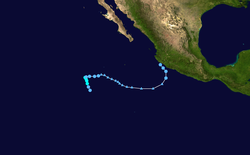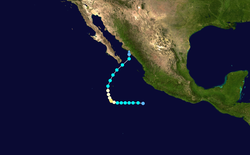The 2006 Pacific hurricane season was an above normal hurricane season with 19 named storms of 11 which were hurricanes and 6 were major hurricanes it was the most active season since 2000 Pacific hurricane season It officially began May 15, 2006 in the eastern Pacific, designated as the area east of 140°W, and began on June 1 2006 in the central Pacific, which is between the International Date Line and 140°W. Both seasons officially ended on November 30, 2006. These dates conventionally delimit the period of each year when most tropical cyclones form in the eastern Pacific basin.
StormsTropical Storm Aletta
| Tropical storm (SSHS)
|
|---|
|
|
| Duration
|
May 27 – May 30
|
|---|
| Intensity
|
45 mph (75 km/h) (1-min), 1002 mbar (hPa)
|
|---|
On May 27 Tropical Depression One-E formed. It became Tropical Storm Aletta later on. Aletta stalled offshore Mexico causing minor damage. Tropical Storm Aletta weakened to a tropical depression and died on May 30.[1]
Tropical Depression Two-E
| Tropical depression (SSHS)
|
|---|
|
|
| Duration
|
June 3 – June 5
|
|---|
| Intensity
|
35 mph (55 km/h) (1-min), 1005 mbar (hPa)
|
|---|
Two-E formed off shore Mexico on June 3. It died 2 days later. Two-E produced 15 inches of rain in Mexico before it died.[2]
Hurricane Bud
| Category 3 hurricane (SSHS)
|
|---|
|
|
| Duration
|
July 11 – July 16
|
|---|
| Intensity
|
125 mph (205 km/h) (1-min), 953 mbar (hPa)
|
|---|
Bud was a Category 3 storm. It rapidly strengthened and then weakened just as fast.
Hurricane Carlota
| Category 1 hurricane (SSHS)
|
|---|
|
|
| Duration
|
July 12 – July 16
|
|---|
| Intensity
|
85 mph (140 km/h) (1-min), 981 mbar (hPa)
|
|---|
Carlota caused light rain in Mexico but no damage was reported. It was a Category 1 storm.
Hurricane Daniel
| Category 4 hurricane (SSHS)
|
|---|
|
|
| Duration
|
July 16 – July 26
|
|---|
| Intensity
|
150 mph (240 km/h) (1-min), 933 mbar (hPa)
|
|---|

Satellite Loop of Hurricane Daniel near peak intensity
Daniel was a long lived Major hurricane that Affected Hawaii with some rain. It peaked as a Category 4. It was the second strongest storm this year.
Tropical Storm Emilia
| Tropical storm (SSHS)
|
|---|
|
|
| Duration
|
July 21 – July 28
|
|---|
| Intensity
|
65 mph (100 km/h) (1-min), 990 mbar (hPa)
|
|---|
It caused some rain in Mexico, causing minor damage.
Tropical Storm Fabio
| Tropical storm (SSHS)
|
|---|
|
|
| Duration
|
July 31 – August 3
|
|---|
| Intensity
|
50 mph (85 km/h) (1-min), 1000 mbar (hPa)
|
|---|
Fabio caused heavy rainfall in Hawaii.
Tropical Storm Gilma
| Tropical storm (SSHS)
|
|---|
|
|
| Duration
|
August 1 – August 3
|
|---|
| Intensity
|
40 mph (65 km/h) (1-min), 1004 mbar (hPa)
|
|---|
Gilma produced light rain in Mexico. It was also the weakest storm so far.
Hurricane Hector
| Category 2 hurricane (SSHS)
|
|---|
|
|
| Duration
|
August 15 – August 23
|
|---|
| Intensity
|
110 mph (175 km/h) (1-min), 966 mbar (hPa)
|
|---|
Hector was a Category 2 hurricane. It made it to the Central Pacific.
Hurricane Ioke
| Category 5 hurricane (SSHS)
|
|---|
|
|
| Duration
|
August 20 – August 27
|
|---|
| Intensity
|
160 mph (260 km/h) (1-min), 915 mbar (hPa)
|
|---|
Ioke was the strongest hurricane ever in the Central Pacific that threated the Johnson Atoll and Wake Island. It formed on august 20. Ioke rapidly became a major hurricane 36 hours later. Ioke went extratropical on September 6. Damage was nearly $100 million. Ioke was retired at the end of the year. It also caused heavy rain in Alaska. Ioke is the most intense storm ever in the central Pacific and the only Category 5 storm that formed in the basin.
Hurricane Illena
| Category 3 hurricane (SSHS)
|
|---|
|
|
| Duration
|
August 21 – August 27
|
|---|
| Intensity
|
120 mph (195 km/h) (1-min), 955 mbar (hPa)
|
|---|
Illena killed one person in Mexico. It peaked as a Cateogory 3 storm.
Hurricane John
| Category 4 hurricane (SSHS)
|
|---|
|
|
| Duration
|
August 28 – September 4
|
|---|
| Intensity
|
135 mph (215 km/h) (1-min), 948 mbar (hPa)
|
|---|
John started as Tropical Depression Eleven-E and later on became a tropical storm and then a hurricane. The hurricane peaked as a Category 4. John killed 5 when it hit Baja California as a Category 2 storm on September 1. Hurricane John died on September 4.[3]
Hurricane Kristy
| Category 1 hurricane (SSHS)
|
|---|
|
|
| Duration
|
August 30 – September 8
|
|---|
| Intensity
|
80 mph (130 km/h) (1-min), 985 mbar (hPa)
|
|---|
Kristy was a Category 1 hurricane that was outflowed by Hurricane John.
Hurricane Lane
| Category 3 hurricane (SSHS)
|
|---|
|
|
| Duration
|
September 13 – September 17
|
|---|
| Intensity
|
125 mph (205 km/h) (1-min), 952 mbar (hPa)
|
|---|
Lane caused severe damage in Mexico, when it hit there as a Category 3 major hurricane. Lane killed 4 people and left $203 million in damage.
Tropical Storm Miriam
| Tropical storm (SSHS)
|
|---|
|
|
| Duration
|
September 16 – September 18
|
|---|
| Intensity
|
45 mph (75 km/h) (1-min), 999 mbar (hPa)
|
|---|
Tropical Depression Two-C
| Tropical depression (SSHS)
|
|---|
|
|
| Duration
|
September 18 – September 20
|
|---|
| Intensity
|
35 mph (55 km/h) (1-min), 1007 mbar (hPa)
|
|---|
Tropical Depression Three-C
| Tropical depression (SSHS)
|
|---|
|
|
| Duration
|
September 26 – September 27
|
|---|
| Intensity
|
35 mph (55 km/h) (1-min), 1007 mbar (hPa)
|
|---|
Three-C was a short lived tropical depression that started several hundred miles southwest of Hawaii. It died the next day while no where near any land.[4]
Tropical Storm Norman
| Tropical storm (SSHS)
|
|---|
|
|
| Duration
|
October 9 – October 15
|
|---|
| Intensity
|
50 mph (85 km/h) (1-min), 1000 mbar (hPa)
|
|---|
Norman struck Mexico as a tropical depression, causing minor damage.
Tropical Storm Olivia
| Tropical storm (SSHS)
|
|---|
|
|
| Duration
|
October 9 – October 12
|
|---|
| Intensity
|
45 mph (75 km/h) (1-min), 1000 mbar (hPa)
|
|---|
Olivia did not affect land.
Tropical Depression Four-C
| Tropical depression (SSHS)
|
|---|
|
|
| Duration
|
October 13 – October 14
|
|---|
| Intensity
|
35 mph (55 km/h) (1-min), 1007 mbar (hPa)
|
|---|
Four-C was a short lived tropical depression. It formed on October 13 and died the next day. The remaims of Four-C caused heavy rain in Hawaii.
Hurricane Paul
| Category 2 hurricane (SSHS)
|
|---|
|
|
| Duration
|
October 21 – October 26
|
|---|
| Intensity
|
105 mph (165 km/h) (1-min), 970 mbar (hPa)
|
|---|
Paul was a Cateogory 2 hurricane that killed 4 in Mexico.
Tropical Depression Eighteen-E
| Tropical depression (SSHS)
|
|---|
|
|
| Duration
|
October 26 – October 27
|
|---|
| Intensity
|
35 mph (55 km/h) (1-min), 1007 mbar (hPa)
|
|---|
Tropical Storm Rosa
| Tropical storm (SSHS)
|
|---|
|
|
| Duration
|
November 8 – November 10
|
|---|
| Intensity
|
40 mph (65 km/h) (1-min), 1002 mbar (hPa)
|
|---|
Rosa produced light rain to Mexico in November.
Tropical Depression Twenty-E
| Tropical depression (SSHS)
|
|---|
|
|
| Duration
|
November 11 – November 11
|
|---|
| Intensity
|
35 mph (55 km/h) (1-min), 1007 mbar (hPa)
|
|---|
Tropical Depression Twenty-E formed and died on the same day, November 11. Twenty-E did not affect any land.[5]
Hurricane Sergio
| Category 2 hurricane (SSHS)
|
|---|
|
|
| Duration
|
November 13 – November 20
|
|---|
| Intensity
|
110 mph (175 km/h) (1-min), 965 mbar (hPa)
|
|---|
Sergio was also a Cateogory 2 storm. It was also the strongest November storm.
Storm names
The following names were used for named storms that formed in the northeast Pacific in 2006.[6] This is the same list that was used in the 2000 season. There were no names retired from the northeast Pacific list. Therefore, the same list was reused in the 2012 season.
|
|
|
- Rosa
- Sergio
- Tara (unused)
- Vicente (unused)
- Willa (unused)
- Xavier (unused)
- Yolanda (unused)
- Zeke (unused)
|
For storms that form in the Central Pacific Hurricane Center's area of responsibility, encompassing the area between 140 degrees west and the International Date Line, all names are used in a series of four rotating lists. The next four names that were slated for use in 2006 are shown below, however only the name Ioke was used.
Retirement
The name Ioke was retired from the north-central Pacific list by the World Meteorological Organization in the spring of 2007 and replaced with Iopa.[7] During the 61st Interdepartmental Hurricane Conference, the Hawaii State Civil Defense requested the retirement of the name Daniel, citing that the storm had become memorable due to threat of damage.[8] However, the request was denied, as the name remains on the tropical cyclone naming list.[6]
Season effects
This is a table of all the storms that formed in the 2006 Pacific hurricane season. It includes their duration, names, landfall(s), denoted in parentheses, damages, and death totals. Deaths in parentheses are additional and indirect (an example of an indirect death would be a traffic accident), but were still related to that storm. Damage and deaths include totals while the storm was extratropical, a wave, or a low, and all the damage figures are in 2006 USD.
2006 Pacific hurricane season statistics
Storm
name
|
Dates active
|
Storm category
at peak intensity
|
Max 1-min
wind
mph (km/h)
|
Min.
press.
(mbar)
|
Areas affected
|
Damage
(USD)
|
Deaths
|
Refs
|
|---|
| Aletta
|
May 27 – 30
|
Tropical storm
|
45 (75)
|
1002
|
None
|
Minimal
|
None
|
|
| Two-E
|
June 3 – 5
|
Tropical depression
|
35 (55)
|
1005
|
Southwestern Mexico, Western Mexico
|
None
|
None
|
|
| Bud
|
July 11 – 16
|
Category 3 hurricane
|
125 (205)
|
953
|
Hawaii
|
None
|
None
|
|
| Carlotta
|
July 12 – 16
|
Category 1 hurricane
|
85 (140)
|
981
|
None
|
None
|
None
|
|
| Daniel
|
July 16 – 26
|
Category 4 hurricane
|
150 (240)
|
933
|
Hawaii
|
None
|
None
|
|
| Emilia
|
July 21 – 28
|
Tropical storm
|
65 (100)
|
990
|
Southwestern Mexico, Western Mexico, Baja California Peninsula, Southwestern United States
|
Minimal
|
None
|
|
| Fabio
|
July 31 – August 3
|
Tropical storm
|
50 (85)
|
1000
|
None
|
None
|
None
|
|
| Gilma
|
August 1 – 3
|
Tropical storm
|
40 (65)
|
1004
|
None
|
None
|
None
|
|
| Hector
|
August 15 – 23
|
Category 2 hurricane
|
110 (175)
|
966
|
None
|
None
|
None
|
|
| Ioke
|
August 20 – 27,[nb 1] |
Category 5 hurricane
|
160 (260)
|
915
|
Johnston Atoll, Wake Island, Minamitorishima, Southern Alaska
|
&10000000088000000000000$88 million
|
None
|
|
| Ileana
|
August 21 – 27
|
Category 3 hurricane
|
125 (205)
|
951
|
Socorro Island
|
Minimal
|
1
|
|
| John
|
August 28 – September 4
|
Category 4 hurricane
|
130 (215)
|
948
|
Guerrero, Michoacán, Baja California Sur, Arizona, California, New Mexico, Texas
|
&10000000060900000000000$60.9 million
|
5
|
|
| Kristy
|
August 30 – September 8
|
Category 1 hurricane
|
80 (130)
|
985
|
None
|
None
|
None
|
|
| Lane
|
September 13 – 17
|
Category 3 hurricane
|
125 (205)
|
952
|
Southwestern Mexico, Western Mexico, Northwestern Mexico, Southwestern United States
|
&10000000203000000000000$203 million
|
4
|
|
| Miriam
|
September 16 – 18
|
Tropical storm
|
45 (75)
|
999
|
None
|
None
|
None
|
|
| Two-C
|
September 19 – 20
|
Tropical depression
|
35 (55)
|
1007
|
None
|
None
|
None
|
|
| Three-C
|
September 26 – 27
|
Tropical depression
|
35 (55)
|
1008
|
None
|
None
|
None
|
|
| Norman
|
October 9 – 15
|
Tropical storm
|
50 (85)
|
1000
|
Southwestern Mexico,[nb 2] Western Mexico
|
None
|
None
|
|
| Olivia
|
October 9 – 12
|
Tropical storm
|
45 (75)
|
1000
|
None
|
None
|
None
|
|
| Four-C
|
October 13 – 14
|
Tropical depression
|
35 (55)
|
1007
|
None
|
None
|
None
|
|
| Paul
|
October 21 – 26
|
Category 2 hurricane
|
105 (165)
|
970
|
Oaxaca, Guerrero, Baja California Sur, Sinaloa
|
&10000000003200000000000$3.2 million
|
4
|
|
| Eighteen-E
|
October 26 – 27
|
Tropical depression
|
35 (55)
|
1007
|
None
|
None
|
None
|
|
| Rosa
|
November 8 – 10
|
Tropical storm
|
40 (65)
|
1002
|
None
|
None
|
None
|
|
| Twenty-E
|
November 11
|
Tropical depression
|
35 (55)
|
1007
|
None
|
None
|
None
|
|
| Sergio
|
November 13 – 20
|
Category 2 hurricane
|
110 (175)
|
965
|
Guerrero
|
None
|
None
|
|
| Season Aggregates
|
|---|
| 25 systems
|
May 27 – November 20
|
|
160 (260)
|
915
|
|
&10000000355100000000000$355 million
|
14
|
|
|---|
2006 Pacific Hurricane Season Media
The cyclone over the northeast Pacific, on November 1
Related pagesNotes
- ↑ Though Hurricane Ioke did not make landfall, its strike on Wake Island is included in the table, due to the severe damage on the island.
- ↑ In its report on Tropical Storm Norman, the National Hurricane Center did not specify whether the storm moved ashore or not. However, in its report to the World Meteorological Organization, officials from Mexico included Norman in the storms that moved ashore along the country.
ReferencesOther websites








